Everything you need to know to successfully care for the green iguana.
The popularity of green iguanas (Iguana iguana) is nothing new. In 1971, nearly 137,000 iguanas were exported from Colombia, with most of them destined for the pet trade in the United States and lesser numbers going to Germany and Japan. By the mid-1990s, the total number of iguanas imported into the U.S. alone had grown to approximately 500,000 annually. After all, who could resist those adorable, foot-long, emerald-green beauties?
Early Years
Very few early reptile enthusiasts could resist such a temptation, myself included. When the pet store clerk said that they cost only a few dollars and you only had to feed them iceberg lettuce (wrong!), it was a done deal. Few iguana purchasers in those days knew what they were getting into.
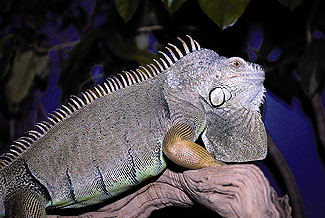
David W. Blair
This is a large, well-marked and colorful male green iguana. Note the enlarged subtympanic scale that distinguishes this species from the Lesser Antillean iguana (Iguana delicatissima)
Remember, 35 years ago there were no iguana Web sites, news groups or chat rooms, virtually no reptile magazines and only a very few basic books that offered iguana care information. The very first iguana captive-care books appeared in the 1960s. Those of us who kept iguanas back then were thrilled to have those 20-page booklets. Unfortunately, much of their information was seriously incomplete. Sometimes, it was simply incorrect.
Without proper care information, most baby green iguanas slowly wasted away. They seldom received sufficient nutrition or proper temperatures, lacked sufficient living space and only rarely, if ever, received exposure to natural sunlight.
All of that was changed by the 1990s. Reptiles were quickly becoming the “in” pets of the 90s, and for several years they represented the fastest growing segment of the entire pet industry. Iguanas led the surge, solidifying their place as the most popular pet reptile of all time. Visitors to reptile expos, which were springing up all over the country, often saw tub after tub of hatchling iguanas, all freshly imported from an ever-growing number of iguana farms located principally in Central America.
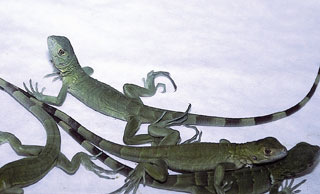
David W. Blair
Hatchling iguanas can be fed the same diet as adults but in smaller portions.
Baby iguanas were so inexpensive to produce on foreign farms, and so plentiful, that retail prices dropped — sometimes to as little as $5 each. But the resources available to reptile hobbyists were also very different by 1995. The Internet was in full swing. Species-specific reptile care books were available, and publishers sought authors who were experts in their field to pen books. The premier issue of REPTILES (October 1993) featured a green iguana on its cover (…and a green iguana article by Mr. Blair. —Eds.).
New owners now had a vast amount of proper iguana care information. In addition, many pet product manufacturers began developing reptile housing, full-spectrum lighting and many other husbandry, dietary and health products. With the emergence of reliable husbandry information and worthwhile products, pet green iguanas began to not only survive, but to thrive and mature in captivity.
New Problems
At 2 to 5 feet or more in length, many iguanas outgrew their original 10- and 20-gallon terrariums. Few commercially available reptile cages were large enough for such immense arboreal lizards; those that were large enough cost hundreds of dollars. Many owners set up an iguana room in their home, or they simply gave their lizards the run of the house.
Proper housing was not the only potential problem iguana owners now faced, however. As many iguanas reached sexual maturity, their needs and behavior changed.
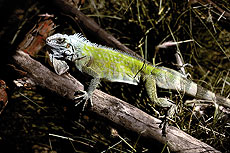
David W. Blair
Note the beautiful blue coloration on this iguana’s head and nape.
Reproductively mature females produce large clutches — 60 to 80 eggs or more — whether or not they have mated with a male. Few were provided with proper nesting areas (which should contain several cubic feet of moistened soil or sand), so many females simply retained their eggs well past the point where they should have been laid. They developed a serious medical condition known as dystocia, requiring immediate hormone injections and/or major surgery. Animals not receiving timely and competent veterinary treatment were often left with massive internal infections, permanent infertility or a slow death.
As many male iguanas matured, they exhibited sudden and sometimes alarming changes in behavior, especially during the breeding season. Pets that had always been sweethearts took on Jekyll-and-Hyde personalities, basking quietly one moment and lunging wildly at an owner’s face or hand the next. Or they might attempt to bite with sharp teeth and a bulldoglike grip. Attacks toward female owners often seemed to coincide with the owners’ monthly menstrual cycle. Bright clothing, especially shades of red, orange, yellow or bright floral prints, appeared to provoke or escalate the behavior.
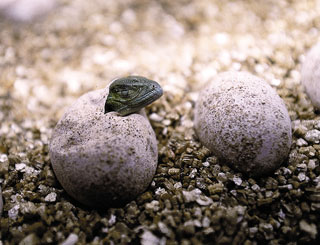
David W. Blair
A baby iguana may remain with just its head protruding from the eggshell for 24 hours or more while it absorbs yolk from its yolk sac.
Having an unpredictable pet, or one that you are afraid of, is not fun.
Buyer Beware
Aggressive behavior by male iguanas is often, but not always, seasonal and may subside outside of the breeding season (the breeding season can vary; wild iguanas throughout their range breed primarily in the late winter and early spring; in Southern California, we see iguanas nesting later, during June and July). Otherwise, not much can be done to correct the situation other than to permanently cage the animal or to isolate it from the object(s) of its aggression. Even the radical decision to surgically neuter a male iguana appears to be effective in controlling aggressive behavior in only about 60 percent of iguanas, and even then it may take up to a year for hormone levels to drop noticeably.
Another possible problem is an owner’s waning interest. Years ago, it was rare for iguanas to live long in captivity. Now, a well-cared-for pet iguana can live up to 20 years. Considering that new iguana owners are often children or young adults, it’s easy to see how their interests and situations may change over a 20-year period. Sometimes no one is left in the family home that has any real interest in the once-cherished iguana.
Consequently, there are now thousands of unwanted adult iguanas in need of new homes. But most novice hobbyists want to start out with a young iguana, not a full-sized adult. Zoos will seldom, if ever, take them. A lucky few do find wonderful new homes through the selfless work of iguana rescue organizations and the adoption committees of regional reptile clubs and societies.
Today, availability seems to have gone nearly full circle. Few iguana hatchlings are currently seen in pet stores or at reptile expos (at least in Southern California, where I reside). You can still find iguanas if you seek them out, but the days of plentiful, dirt-cheap hatchlings are gone, which is certainly for the better.
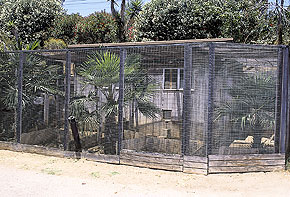
David W. Blair
Outdoor enclosures allow beneficial exposure to natural sunlight on a daily basis and should also include shady areas to prevent iguanas from overheating.
The truth is that the iguana is not a good beginner’s pet. It is not an easy-care pet. It is certainly not an appropriate child’s pet. It is a very large, arboreal lizard that requires specialized care, a large amount of space and adult handling and supervision.
For the right individual, however, it is all worth it, because the green iguana is a truly spectacular reptile. It is not only one of the largest and most impressive lizards in the Western Hemisphere, but one of the most beautiful as well.
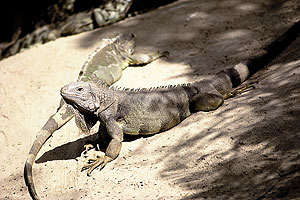
David W. Blair
Adult female iguanas may not be as colorful as some males, and they usually have proportionately smaller heads and jowls.
Natural History
The green iguana has a very large geographic distribution from Sinaloa and Veracruz in northern Mexico, southward through Central America and into northeastern South America to at least the Tropic of Capricorn in southeastern Brazil and Paraguay. It is also found on numerous islands in the Caribbean. Introduced populations have also become established in localized areas of southern Florida.
The Lesser Antillean iguana (Iguana delicatissima), which differs from the common green iguana in its lack of the enlarged subtympanic scale (located just below the external ear covering), is found on several islands in the Lesser Antilles. This species is not available in the pet trade.
Mature female iguanas may reach lengths of more than 4 feet and can weigh up to 8 pounds. Adult males may exceed 6 feet and have been known to reach captive weights of more than 15 pounds. They are almost entirely herbivorous as juveniles and adults, and as such they rely on hindgut fermentation for digestion. They feed on the leaves, flowers and fruits of many different plants; their diet varies greatly both seasonally and geographically. They are arboreal by nature and are most at home in tropical lowlands under 1,650 feet in elevation.
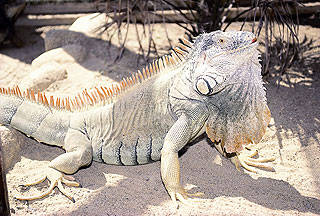
David W. Blair
This is “Bullwhip,” the largest green iguana the author has ever owned. He was 74 inches in overall length at last measurement.
Selecting an Iguana
There are several things to look for when selecting a pet iguana. A healthy iguana will be alert, bright eyed and active during daylight hours. It should be in good weight but not have a distended stomach or swollen-looking limbs. The feces or droppings should be fairly firm and not runny; the underside of the animal should be relatively clean and not stained with feces. The skin should appear clean, normal and free of unusual lumps under the skin, small black spots on the skin, open wounds or ulcerations.
Try to determine if the animal is reasonably calm and not terrified of you, but never mistake lethargy for “tameness.” Healthy animals can move very quickly when they want. If possible, request to see the animal feed to observe if it is eating well, and ask questions to determine if the previous owner has fed the iguana a good, balanced diet.
In some areas, reptile retailers work with local veterinarians to offer a free initial examination after the purchase. Take advantage of this offer and also be willing to pay the optional small fee to have a fecal analysis performed at that time to check for endoparasites which, if present, should be treated.
After your new iguana settles into its new enclosure and begins feeding normally, start handling and socializing your pet. A good schedule to start with is 15 to 20 minutes daily or every other day. You will have better results if you attempt handling during the cooler morning or evening hours. Iguanas can be rambunctious by the middle of the day after they’ve been basking under a heat source.
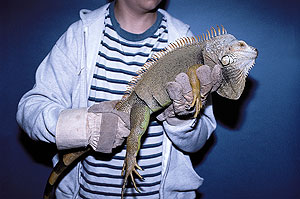
David W. Blair
Under adult supervision, this child demonstrates a safe handling technique. Note the gloves and long-sleeved jacket worn for added protection.
Housing
Iguanas can be housed in a wide variety of enclosures: traditional glass terrariums with screen tops, wooden cages with glass fronts, molded plastic cages with sliding glass front doors and all-screen or wire cages. Almost any of these work well if they are coupled with a heat source that can maintain proper temperatures both day and night, and if they can accommodate a full-spectrum light and fixture.
Hatchling iguanas can be started in a cage as small as 20 gallons (about 24 inches long by 12 inches wide by 16 inches tall), but they will quickly outgrow it. A 40- to 60-gallon terrarium is much more practical and should be able to house the iguana for at least one to two years. At a minimum, a breeding pair of adult iguanas needs an enclosure that is 8 feet long by 8 feet wide by 6 feet tall, equipped with basking and feeding sites, climbing branches and a suitable nesting area.
Heating
Heat sources for smaller enclosures include undertank heaters and overhead light bulbs or heat emitters. Larger enclosures can utilize rigid heat mats, also known as “pig blankets,” radiant heat panels and space heaters. Nearly any heat source can be regulated with the use of automatic thermostats or manual rheostats. Create a temperature gradient within the cage that runs from near 85 degrees Fahrenheit in the cooler end to about 95 in the warmer end.
Also provide a basking area near the heat source, where the iguana can raise its body temperature to between 100 and 105 degrees. Be careful not to allow temperatures anywhere within the enclosure to exceed this limit. There should be a physical barrier, such as a screen or wire mesh, between the iguana and the heat source to prevent direct contact burns. Nighttime temperatures may drop to 70 to 75 degrees for hatchlings, and to as low as 60 degrees for acclimated adult iguanas kept outdoors.
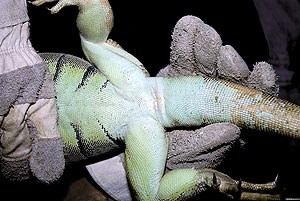
David W. Blair
The most accurate method of sexing green iguanas is to use probes. The female iguana shown here lacks the enlarged femoral pores of adult males.
Lighting
The most beneficial light for your iguana is unfiltered (meaning not coming through glass) natural sunlight. Every effort should be made to expose your animal to direct sunlight for a minimum of four to six hours every week, more if possible. This can be done by placing your iguana outdoors in a screen-mesh sunning cage or by setting up a basking platform in front of a south-facing, open window with a secure window screen in place to prevent escape. Be sure to provide shade as well, so that your iguana can move out of the sunlight if it becomes too warm.
When exposure to natural sunlight is not possible, artificial full-spectrum lamps may be used. The term “full-spectrum” was originally coined by a fluorescent light manufacturer to describe a product that had a light output that was very similar to the spectrum of natural sunlight. That spectrum includes both the visible light spectrum and the ultraviolet (UV) spectrum, which is invisible to humans.
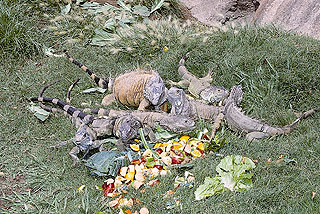
David W. Blair
This group of green iguanas is thriving in a zoological garden and includes at least one adult male and several adult females.
Such lights not only illuminate a reptile enclosure but also provide the animals with exposure to beneficial UVA and UVB light. The UVB is important because it enables a reptile exposed to it to generate vitamin D3 precursors. Once converted within the animal’s system, the vitamin D3 allows the reptile to utilize dietary calcium to generate strong bones and teeth, enable muscle function and more.
The term “full-spectrum” is often used inappropriately to describe many incandescent, screw-in-base light bulbs that incorporate a coating or material in the glass to create a bright, white light but which produce virtually no UVB. These bulbs are fine for illumination or to use as a heat source in an iguana enclosure. However, if you want to provide your iguana with UVB from an artificial light source, you should stick with top-rated fluorescent bulbs or the newer mercury vapor lamps, which are specifically labeled for reptile use and state on their packaging that they produce measurable levels of UVB. According to several of the manufacturers of these lamps, most should be replaced at least every six to 12 months to ensure full output of UVB.
Feeding and Watering
Few areas of iguana care generate as much debate and discussion as the question of what is an appropriate diet for these lizards. Very few long-term studies have been done on the diets of wild iguanas. It is suspected that iguanas in nature are opportunistic feeders and that their diet can vary greatly both seasonally and geographically. Certainly different food items may be available to them at different times of the year and in different locations. At any given time, 80 percent or more of their daily diet may consist of the leaves of just a single plant. Over an entire year, however, their diet is likely to be much more varied.
I feed my captive green iguanas what I call a “common sense” diet (i.e., one based on my own and others’ experiences and successes in raising and breeding iguanas, and not on any scientific study or analysis). Some readers may disagree with certain aspects of this diet, or they may have a diet of their own that they prefer. I will simply state that in more than 30 years of feeding the following diet to nearly 1,000 iguanas and tortoises, not a single animal that I’ve produced has developed any nutritionally based deficiency, medical condition or disease.
I begin with a base of about 70 percent (by weight) of green leafy vegetables that have a positive calcium-to-phosphorus ratio (collard greens, mustard greens, turnip greens, parsley, kale, dandelion greens, etc.). Next, I add about 20 percent mixed vegetables (squash, beans, peas, carrots, corn, bean sprouts, etc.). The final 10 percent of the diet is assorted fruit (figs, grapes, apples, pears, plums, melon, mangos, papaya, etc.). A very small amount of dry, low-fat moistened dog or primate chow can be added to the mix as an additional option.
All food is chopped into pieces of appropriate size for the iguana being fed. I offer food to juveniles every other day and to adults three times each week. If you feed every day, be certain to offer only an amount that can be consumed completely in that same day and that your iguana is not just picking out its favorite foods and leaving the rest. I thoroughly mix into the prepared food a small amount of calcium supplement twice each week and a reptile multivitamin supplement once each week.
Water containers for drinking are present in the cage at all times and are kept clean. Most iguanas also will soak their entire bodies in larger water containers. They often defecate while soaking, so be sure to keep these containers clean.
Conclusion
Green iguanas are not an appropriate pet for many people. For those who thoroughly research their needs and are prepared to commit the time, space and resources that they require and deserve, iguanas can be extremely rewarding.
Many years ago, my son Ryan, then only about 12, while working with me in our booths at reptile expos, coined the term “Iguana Mamas” for certain customers who would stop by our booth and talk to him about their pet iguanas. He did not mean the term in any derogatory way; it was a term of endearment for many iguana owners, mostly female, who were passionate about their iguanas. They would tell him about their iguanas, just as if they were their own children, often pulling out photos of their cherished “kids” and their latest antics.
Their passion for their pet iguanas was infectious, and we were sure that their lucky iguanas would always get the best care. If you are the type of person who can share that kind of passion for a pet lizard, then the green iguana is likely a very good choice for you.


